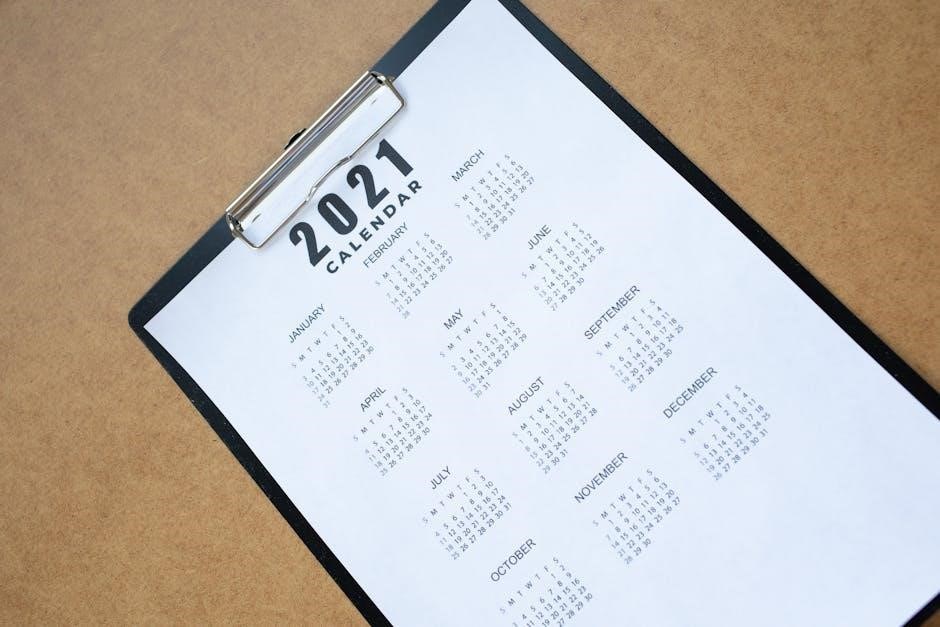The 2021 Honda Pilot Maintenance Schedule PDF is a comprehensive guide outlining essential service intervals and procedures to keep your vehicle running smoothly and reliably.
Understanding the Importance of Regular Maintenance
Regular maintenance is crucial for ensuring the 2021 Honda Pilot operates safely, efficiently, and reliably. Neglecting scheduled services can lead to decreased performance, higher fuel consumption, and potential breakdowns. By following the recommended maintenance intervals, owners can prevent minor issues from becoming costly repairs. Proper upkeep also maintains the vehicle’s emissions control, ensuring environmental compliance. The maintenance schedule is designed to address critical systems, such as engine, transmission, and brakes, at specific milestones. Adhering to this routine not only safeguards the vehicle’s longevity but also protects the owner’s investment, providing peace of mind and uninterrupted driving experiences.

Key Maintenance Intervals for the 2021 Honda Pilot
Normal Driving Conditions Schedule
For normal driving, maintenance is required at 7,500 to 120,000 miles, including oil changes, tire rotations, and inspections. This ensures optimal performance and longevity for your Honda Pilot.
The 2021 Honda Pilot maintenance schedule under normal driving conditions recommends services at specific mileage intervals to ensure optimal performance and longevity. Starting at 7,500 miles, routine maintenance includes oil changes, tire rotations, and inspections of essential components like brakes and belts. Services are required at 7,500, 15,000, 30,000, and continuing up to 120,000 miles. Adhering to this schedule helps maintain fuel efficiency, prevents unexpected repairs, and ensures the vehicle operates safely and reliably. Regular checks and timely replacements of fluids and parts are crucial for sustaining the Honda Pilot’s durability and performance under typical driving conditions.
Severe Driving Conditions Schedule
The 2021 Honda Pilot maintenance schedule under severe driving conditions requires more frequent servicing to address the added stress on the vehicle. If driving in extreme temperatures, towing, or dusty environments, services like oil changes and tire rotations should occur every 5,000 to 7,500 miles. Brake fluid and transmission fluid replacements are recommended more often to prevent wear. Additionally, the rear differential and transfer case fluids may need to be changed every 15,000 to 30,000 miles. Following this schedule ensures the Pilot performs reliably under demanding conditions and avoids potential damage from neglecting critical maintenance tasks.

Oil Change Intervals and Recommendations
The 2021 Honda Pilot requires oil changes every 7,500 to 10,000 miles under normal conditions, using 0W-20 viscosity grade oil for optimal performance and engine protection.
Recommended Oil Viscosity Grades
The 2021 Honda Pilot requires 0W-20 viscosity grade oil for optimal performance and fuel efficiency. This grade ensures proper engine lubrication in various temperatures, reducing friction and wear. Always use oil that meets Honda’s standards to maintain engine health and longevity. Check the owner’s manual or consult a Honda service center for confirmation. Using the correct viscosity is crucial for preserving your Pilot’s performance and warranty. Proper oil choice helps maintain fuel efficiency and prevents potential engine damage. Adhere to these guidelines to ensure your vehicle runs smoothly under all driving conditions. Regular oil checks are also essential for maintaining your Pilot’s overall health.
Oil Change Frequency
The 2021 Honda Pilot recommends oil changes every 7,500 miles under normal driving conditions. Severe conditions may require more frequent changes, around 5,000 miles. Always use 0W-20 viscosity oil for optimal performance. Regular oil changes ensure engine longevity and prevent damage. Check the maintenance schedule PDF for specific intervals. Honda dealerships can provide precise recommendations based on your driving habits. Adhering to this schedule maintains fuel efficiency and overall vehicle health. Neglecting regular oil changes can lead to decreased performance and potential engine issues. Stay proactive with oil changes to keep your Pilot running smoothly.
Tire Rotation Schedule
The 2021 Honda Pilot recommends tire rotations every 7,500 to 10,000 miles to ensure even tread wear and maximize tire life. Follow the PDF schedule for details.
Importance of Regular Tire Rotations
Regular tire rotations are crucial for maintaining even tread wear, ensuring optimal performance, and extending tire life. Uneven wear can lead to reduced traction, compromising safety, especially in adverse conditions. By following the recommended schedule, you prevent uneven patterns that can shorten tire longevity. Proper rotations also improve fuel efficiency, as misaligned or unevenly worn tires can increase engine strain. Additionally, regular rotations ensure consistent handling and stability, making your 2021 Honda Pilot safer and more reliable. Adhering to the maintenance schedule helps maintain your vehicle’s performance and prevents costly repairs down the road.
Recommended Tire Rotation Intervals
The 2021 Honda Pilot maintenance schedule recommends tire rotations every 7,500 to 10,000 miles under normal driving conditions. For vehicles driven under severe conditions, such as frequent stop-and-go traffic or extreme temperatures, rotations should occur every 5,000 to 7,500 miles. Adhering to these intervals ensures even tread wear and prevents uneven patterns that can compromise safety and reduce tire life. Proper rotation also enhances handling and fuel efficiency. Always refer to the PDF guide for specific instructions tailored to your driving habits and conditions to maintain optimal performance and extend the lifespan of your tires.

Fluid Replacement Schedule
The 2021 Honda Pilot maintenance schedule outlines essential fluid replacements, including brake fluid every 30,000-60,000 miles, transmission fluid every 30,000-60,000 miles, and coolant every 90,000-105,000 miles.
Brake Fluid Replacement
Brake fluid replacement is crucial for maintaining the 2021 Honda Pilot’s braking system performance. The schedule recommends changing the brake fluid every 30,000 to 60,000 miles, depending on driving conditions. Using the correct fluid type, such as Honda Heavy Duty Brake Fluid, ensures optimal braking efficiency and prevents corrosion in the system. Neglecting this maintenance can lead to reduced brake performance and potential safety risks. Always consult the owner’s manual or the PDF guide for specific recommendations tailored to your vehicle’s needs. Proper brake fluid maintenance is essential for reliable and safe operation of your Honda Pilot.
Transmission Fluid Replacement
Transmission fluid replacement is essential for maintaining the smooth operation of your 2021 Honda Pilot’s transmission system. The recommended interval for transmission fluid replacement is typically every 30,000 to 60,000 miles, depending on driving conditions. Using Honda-approved transmission fluid ensures optimal performance and prevents system damage. Signs of needing replacement include slipping gears or unusual noises. Regular fluid changes help maintain lubrication, reduce wear, and prevent overheating. Refer to the 2021 Honda Pilot Maintenance Schedule PDF for precise guidelines tailored to your vehicle’s needs. Proper transmission fluid maintenance is vital for long-term reliability and performance.
Coolant Replacement
Coolant replacement is a critical component of the 2021 Honda Pilot maintenance schedule, ensuring the engine operates within optimal temperature ranges. The recommended coolant replacement interval is typically around 100,000 miles or as specified in the schedule. Using the correct Honda-approved coolant type is essential to prevent corrosion and maintain proper cooling system efficiency. The coolant should be inspected for leaks and levels during regular maintenance checkups. Proper coolant replacement helps prevent overheating, extends engine life, and ensures reliable performance. Refer to the 2021 Honda Pilot Maintenance Schedule PDF for detailed guidelines on coolant replacement procedures and intervals.

Inspection Checklists
The 2021 Honda Pilot maintenance schedule includes detailed inspection checklists for tires, brakes, belts, and fluids to ensure reliability and prevent potential issues through regular evaluations.
Engine Inspection Checklist
The engine inspection checklist for the 2021 Honda Pilot includes checking oil and coolant levels, looking for leaks, inspecting the air filter, and verifying belt condition. Ensure the serpentine belt is free of cracks, and inspect the engine for any signs of wear or damage. Additionally, check the coolant hoses for cracks or soft spots, and verify proper tension on all belts. Monitor the engine’s performance for unusual noises, vibrations, or Dashboard warning lights. Regular inspections help identify issues early, preventing costly repairs. Always refer to the PDF guide for detailed procedures and recommendations specific to your vehicle.
Tire Inspection Checklist
The tire inspection checklist for the 2021 Honda Pilot includes checking tire pressure, inspecting for uneven wear, and verifying tread depth. Look for cracks in sidewalls and ensure valve stems are tightly sealed. Rotate tires every 7,500 to 10,000 miles to promote even wear. Inspect for punctures or damage and replace tires if necessary. Proper tire maintenance ensures safety, improves fuel efficiency, and extends tire life. Always refer to the PDF guide for specific recommendations and procedures to keep your Honda Pilot running smoothly and safely on the road.

Accessing the 2021 Honda Pilot Maintenance Schedule PDF
The 2021 Honda Pilot Maintenance Schedule PDF is available for download from Honda’s official website, authorized dealerships, or online platforms like CarManualsOnline.info, ensuring easy access for owners.
Downloading the PDF Guide
The 2021 Honda Pilot Maintenance Schedule PDF can be downloaded directly from Honda’s official website or trusted platforms like CarManualsOnline.info. Simply visit the site, search for the 2021 Honda Pilot, and navigate to the service manual section. The PDF is free to download and contains 739 pages of detailed maintenance information; Ensure you have a PDF viewer installed to access the guide. For convenience, save the file to your device or print it for easy reference. This guide is essential for staying updated on your vehicle’s maintenance needs and ensuring optimal performance.
Navigating the PDF Document
The 2021 Honda Pilot Maintenance Schedule PDF is a well-organized document designed for easy navigation. It begins with an introduction, followed by detailed maintenance intervals broken down by mileage, starting from 7,500 miles up to 120,000 miles. The guide includes clear sections for oil changes, tire rotations, fluid replacements, and inspection checklists. Users can quickly locate specific information using the table of contents or index. The document also emphasizes the importance of adhering to the recommended schedule to ensure the vehicle’s safety, reliability, and performance. This comprehensive guide is essential for all Honda Pilot owners to keep their vehicle in optimal condition.

Role of Honda Dealerships in Maintenance
Honda dealerships play a crucial role in maintaining your 2021 Pilot, offering expert technicians, genuine parts, and personalized service advice to ensure reliability and performance.
Authorized Service Centers
Authorized Honda service centers are the best choice for maintaining your 2021 Pilot, offering expert technicians trained to handle specific Honda models. They use genuine parts and specialized tools to ensure services align with Honda’s standards. These centers provide a comprehensive understanding of the maintenance schedule, ensuring all recommended services are performed accurately. By adhering to the outlined intervals, they help maintain your vehicle’s optimal performance, reliability, and long-term value; Visiting an authorized service center guarantees peace of mind, knowing your Pilot is in the hands of professionals who understand its unique needs and requirements.
Trustworthy Maintenance Advice
Authorized Honda service centers provide trustworthy maintenance advice tailored to your 2021 Pilot’s needs. Their expertise ensures services are performed correctly, adhering to Honda’s guidelines. Technicians use genuine parts and recommend services based on your driving habits and mileage. They offer personalized advice to extend your vehicle’s lifespan and performance. By following their guidance, you ensure your Pilot remains reliable and efficient. Their transparent approach helps you understand the importance of each service, giving you confidence in your maintenance decisions and peace of mind knowing your vehicle is well-cared-for.

Additional Maintenance Services
Additional maintenance services for the 2021 Honda Pilot include air filter replacements and belt inspections to ensure optimal performance and prevent premature wear on critical components.
Air Filter Replacement
Air filter replacement is crucial for maintaining the 2021 Honda Pilot’s performance and fuel efficiency. The engine air filter should be replaced every 15,000 to 30,000 miles, depending on driving conditions. A dirty air filter can decrease engine performance, reduce gas mileage, and increase emissions. Regular inspections are recommended to ensure optimal airflow and proper engine operation. The cabin air filter, which improves interior air quality, should also be replaced annually or as needed. Replacing these filters with Genuine Honda parts ensures compatibility and maintains the vehicle’s warranty. Always refer to the maintenance schedule for precise intervals and guidelines.
Belt Replacements
Belt replacements are essential for the 2021 Honda Pilot’s long-term reliability. The timing belt is typically replaced at 105,000 miles to prevent engine damage. Serpentine belts should be inspected every 50,000 miles and replaced at 90,000 miles or when signs of wear appear. Regular belt replacements ensure proper engine operation, prevent breakdowns, and maintain optimal performance. Always use Genuine Honda parts for compatibility and warranty compliance. Follow the recommended intervals in the maintenance schedule to avoid costly repairs and keep your Pilot running smoothly; Proper belt maintenance is vital for the vehicle’s overall health and longevity.

Diagnostic Tools and Maintenance
Diagnostic tools monitor the 2021 Honda Pilot’s systems, providing real-time data for maintenance needs. Some diagnostic information is uploaded to Honda upon vehicle start-up, aiding in proactive service planning.
Diagnostic Information Upload
The 2021 Honda Pilot features advanced diagnostic tools that upload maintenance-related data to Honda upon vehicle start-up. This system provides insights into the vehicle’s condition, enabling proactive service planning. It tracks essential metrics like oil life, fluid levels, and system performance, ensuring timely interventions. Dealerships can access this data to recommend necessary services, enhancing maintenance efficiency. This feature streamlines diagnostics, reducing the need for manual checks and ensuring your Pilot remains in optimal condition. Always consult your owner’s manual or contact an authorized dealership for more details on this innovative maintenance support system.

2021 Honda Pilot Owner’s Manual
The 2021 Honda Pilot Owner’s Manual is a detailed guide available for download as a free PDF. It provides comprehensive information on vehicle operation, maintenance, and features, ensuring owners can optimize their driving experience and adhere to recommended service schedules.
Using the Owner’s Manual for Maintenance
The 2021 Honda Pilot Owner’s Manual is an essential resource for maintenance, providing detailed schedules, service intervals, and procedures. It guides owners on oil changes, tire rotations, and fluid replacements, ensuring optimal vehicle performance. The manual also covers inspection checklists and recommends when to replace parts like air filters and belts. By following the manual, owners can prevent potential issues, maintain warranty compliance, and extend their vehicle’s lifespan. Available as a free PDF download, it offers clear instructions to help owners stay on track with their maintenance needs efficiently and effectively.
Importance of Adhering to the Schedule
Adhering to the 2021 Honda Pilot maintenance schedule is crucial for preventing breakdowns, ensuring safety, and maintaining optimal performance. Regular maintenance prevents costly repairs and preserves your vehicle’s condition over time.
Consequences of Neglecting Maintenance
Neglecting the 2021 Honda Pilot maintenance schedule can lead to serious consequences, including increased repair costs, breakdowns, and potential system failures. Overlooking oil changes and fluid checks can cause engine damage, while skipped tire rotations may result in uneven wear and reduced traction. Ignoring brake fluid and coolant replacements can compromise safety and lead to costly repairs. Additionally, poor maintenance habits can reduce fuel efficiency and shorten the vehicle’s lifespan. Consistent adherence to the schedule ensures optimal performance, safety, and long-term reliability of your Honda Pilot.
Adhering to the 2021 Honda Pilot maintenance schedule ensures optimal performance and longevity, preventing costly repairs and ensuring reliability. Refer to the PDF guide for detailed procedures and timelines.
Final Thoughts on Maintenance
Regular maintenance is crucial for the longevity and performance of your 2021 Honda Pilot. The PDF guide provides clear, mileage-based recommendations for services like oil changes, tire rotations, and fluid replacements. By following the schedule, you can prevent unexpected repairs, ensure reliability, and maintain your vehicle’s resale value. Trust the comprehensive guide to keep your Pilot running smoothly for years to come. Always use genuine Honda parts and consult authorized dealers for expert advice. Stay proactive with maintenance to enjoy a hassle-free driving experience.
